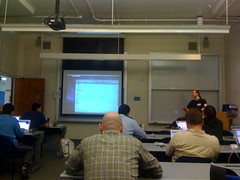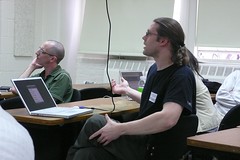Session One “Installing SDK and ‘Hello World’” (or Bonjour Monde :-) with Shawn Van Every and Eric Redlinger
 Photo by cstoller
Photo by cstoller
Well, I wanted to get my hands dirty in the IDE. So, I went to the SDK installation, and xCode introduction. I’ve been through the tutorials, but thought that some real face-time instruction would be good.
It was pretty straight forward, but this was way cool, though: Bonjour technology can connect other phones over WiFi. There is some sample code that allows you see how this works on the wiki page. (Link Below)
I didn’t get my “Hello World” to even say “hi,” but I also had to cut it short before tweaking it because we wanted to get into what we thought would be the app for us: Interface Builder.
IB is tricky, definitely fun, but I don’t see how I could use it in my workflow just yet. It’s still really buggy and not complete. Some where saying that it’s the weakest part of the SDK. Certainly didn’t do it for me at this point.
(See Links at end of post for notes.)
Session 2: User Experience with Chris Fahey and Rob Marini
This, for me, and perhaps many others because the room was packed, was the headline event. The iPhone is in such infancy that we’re all starving and grasping for what it takes to make a great app for the device. In case you don’t know, Apple (they’re not the only one’s, though, they’re just one of the more well-known) puts User Experience at the front-end of the development process. I reiterate this as it’s a relatively new notion for software developers who are used to system-driven UI design.
Which is kind of a “duh.” I mean, if you’re creating something for an audience, shouldn’t you have a deep understanding of that audience? Anyway, another topic for another day.
 Photo by bisceglie
Photo by bisceglie
Chris showed off his densely-layered Photoshop interface prototype maker – complete with moveable finger (unfortunately not shown)– from which he hand-stiched various screen shots he found on the Web (he’ll be releasing to the public soon, watch graphpaper.com). He was quick to point out that he did his protoype Pre-SDK release with InterfaceBuilder (IB), but Rob actually advised against using IB for making prototypes anyway. There’s just too much time involved. Perhaps it will get better/easier, but right now, as designers,we should stick with what we know.
Prototyping is an extremely important part of the design process, but not the first. It’s best to start of with a graph-paper sketch pad. Chris suggested to use one the size of an actual handheld. I think this might be what he’s talking about: Moleskine (scroll to bottom of the page).
The photoshop file was definitely an undertaking on his part, but the take-away from Fahey’s presentation is this: design is sometimes the “Art of taking features out.” Sure, in the initial phases, jam-pack a concept with features, but then give it a critical look to take out stuff; what I like to call “design triage.”
Actually there is another take away, “Get pixel-perfect as soon as you can.” Many designers are coming from desktop or Web design where screen real estate is a luxury compared to the iPhone. So, it’s really important to see what it’s truly going to look like.
Rob Marini really got some great discussion going. One of Rob’s points was that once a prototype is really fleshed out and the experience is coming together, then start bringing things into UI Builder.
Rob’s posted his notes on his site: The New High Standard.
Warning For the Developer
Eric Redlinger, creator of CrossWalk a handy Subway map app for NYC, pointed out to programmers: if you worked with pre-beta “unofficial SDK” don’t be surprised if everything gets thrown out. Apparently, Apple’s made a ton of changes to the CocoaTouch’s (iPhone rendition of Cocoa) methods and syntax.
 Photo by cstoller
Photo by cstoller
Webkit Areas for Native Development
Here’s an interesting idea. Something I was pondering as I’ve played with xTools: design and develop using Webkit with a “thin CocoaTouch layer” and then turn it into a iPhone app. Apparently, the guys were saying that this is a perfectly valid way to develop because “Webkit views” will run with the benefits of a native app having that thin Cocoa layer, but easy enough for Web technologists to get apps rapidly built. Some features like camera, corelocation are not available through Webkit, but that’s where the native aspect can come in.
Eric allowed us to rip up his CrossWalk app, but unfortunately I had to jet off to a friend’s Seder. So, I couldn’t participate much.
Here’s some other helpful Webkit topics:
SproutCore – OpenSource framework for Web. Think of it as Cocoa for the Web.
iUI – is another option, but a little immature.
Anyway, this iPhoneDevCamp was my first BarCamp experience. It was awesome, definitely will be attending more in the future. If you’re in the technology dev/design industry in any capacity, either go to one or get one started if they’re not available in your area.
Thanks for the volunteering and sponsorship:
- Eric Redlinger: CrossWalk
- Michael Sharon
- Hans-Christoph Steiner
- Shawn Van Every
- IDMI at PolyTech
- Socialight
- Organic
- PinchMedia
- ZWorkBench
- ITP at NYU
More linkage:
- TUAW
- HyperRadiant’s Notes from the Interface Builder Session
- CocoaHeadsNYC Yahoo! Group
- iPhoneDevcampNYC Wiki with Samples Link and IRC Channel
- BarCamp.org
Please, by all means add more local groups, events, blog posts, reviews, software downloads, help files, (whatever) in the comments and I’ll update. If you were there, definitely put your comments below or link to your site.
These are the notes I wrote up today talking about iPhone UX.
http://thenewhighstandard.com/post/32383983
Hey Robert, Thanks for the link. It was cool meeting you and thanks for your presentation. We’ll have to keep in touch. (link posted)